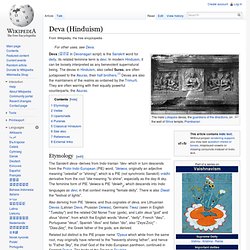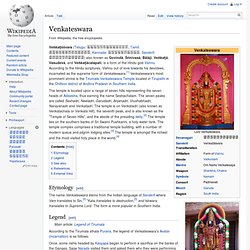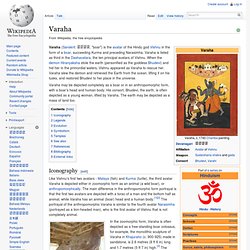

Yuga. Yuga (Devanāgari: युग) in Hindu philosophy is the name of an epoch or era within a four age cycle.

According to Hindu cosmology, life in the universe is created and destroyed once every 4.1 to 8.2 billion years,[1][2] which is one full day (day and night) for Brahma. The lifetime of a Brahma himself may be between 40 billion and 311 trillion years.[1] The cycles are said to repeat like the seasons, waxing and waning within a greater time-cycle of the creation and destruction of the universe. Like Summer, Spring, Winter and Autumn, each yuga involves stages or gradual changes which the earth and the consciousness of mankind goes through as a whole. A complete yuga cycle from a high Golden Age, called the Satya Yuga to a Dark Age, Kali Yuga and back again is said to be caused by the solar system's motion around another star.[3] Durations of four yugas[edit] Kalki. In Hinduism, Kalki (Devanagari: कल्कि; meaning 'Eternity,' 'White Horse,' or 'Destroyer of Filth') is the final incarnation of Vishnu in the current Mahayuga, foretold to appear at the end of Kali Yuga, the current epoch.

Religious texts called the Puranas foretell that Kalki will be atop a white horse with a drawn blazing sword. He is the harbinger of the end time in Hindu eschatology, after which he will usher in Satya Yuga. In Buddhist Kalachakra tradition, 25 rulers of the Shambhala Kingdom held the title of Kalki, Kulika or Kalki-king.[3] During Vaishakha, the first fortnight in Shukla Paksha is dedicated to fifteen deities, with each day for a different god.
In this tradition, the twelfth day is Vaishakha Dwadashi and is dedicated to Madhava, another name for Kalki. Maha Avatara[edit] There are numerous interpretations of Vedic tradition. Puranas[edit] Birth[edit] As written in the Kalki Purana: Literal translation: शम्भल ग्राम मुख्यस्य ब्राह्मणस्य महात्मनः। Deva (Hinduism) Deva (देव in Devanagari script) is the Sanskrit word for deity, its related feminine term is devi.

In modern Hinduism, it can be loosely interpreted as any benevolent supernatural being. The devas in Hinduism, also called Suras, are often juxtaposed to the Asuras, their half brothers.[1] Devas are also the maintainers of the realms as ordained by the Trimurti. They are often warring with their equally powerful counterparts, the Asuras. The Sanskrit deva- derives from Indo-Iranian *dev- which in turn descends from the Proto-Indo-European (PIE) word, *deiwos, originally an adjective meaning "celestial" or "shining", which is a PIE (not synchronic Sanskrit) vrddhi derivative from the root *diw meaning "to shine", especially as the day-lit sky. The feminine form of PIE *deiwos is PIE *deiwih2, which descends into Indic languages as devi, in that context meaning "female deity". Hiranyagarbha. Click an area to go there.

This is one of many material universes, Brahmāṇḍa, which expand from Mahā Viṣṇu when He breathes. Hiraṇyagarbha (Devanagari: हिरण्यगर्भः ; literally the 'golden womb' or 'golden egg', poetically rendered 'universal germ') is the source of the creation of the Universe or the manifested cosmos in Indian philosophy,[1] it finds mention in one hymn of the Ṛigveda (RV 10.121), known as the 'Hiraṇyagarbha Sūkta', suggesting a single creator deity(verse 8: yo deveṣv ādhi devā eka āsīt, Griffith:"He is the God of gods, and none beside him. "), in the hymn identified as Prajāpati The concept golden womb is again mentioned in Viswakarma suktha Rg 10-82. The Upaṇiṣad calls it the Soul of the Universe or Brahman,[2] and elaborates that Hiraṇyagarbha floated around in emptiness and the darkness of the non-existence for about a year, and then broke into two halves which formed the Svarga and the Pṛthvi.
Creation[edit] Hiraṇyagarbha Shaligram Shila For Altar[edit] 1. 2. 3. 4. 5. Hindu cosmology. Hinduism. Venkateswara. The temple is located upon a range of seven hills representing the seven heads of Adisesha, thus earning the name Seshachalam.

The seven peaks are called Seshadri, Neeladri, Garudadri, Anjanadri, Vrushabhadri, Narayanadri and Venkatadri. The temple is on Venkatadri (also known as Venkatachala or Venkata Hill), the seventh peak, and is also known as the "Temple of Seven Hills", and the abode of the presiding deity.[2] The temple lies on the southern banks of Sri Swami Pushkarini, a holy water tank. The temple complex comprises a traditional temple building, with a number of modern queue and pilgrim lodging sites.[3] The temple is amongst the richest and the most visited holy place in the world.[4] Replica of Lord Venkateswara at Dwaraka Tirumala, Andhra Pradesh Etymology[edit] The name Venkateswara stems from the Indian language of Sanskrit where Vem translates to Sin,[5] "Kata translates to destruction,[5] and Ishwara translates to Supreme Lord. Legend[edit] See also[edit] References[edit]
Varaha. Varaha (Sanskrit: वराह, "boar") is the avatar of the Hindu god Vishnu in the form of a boar, succeeding Kurma and preceding Narasimha.

Varaha is listed as third in the Dashavatara, the ten principal avatars of Vishnu. When the demon Hiranyaksha stole the earth (personified as the goddess Bhudevi) and hid her in the primordial waters, Vishnu appeared as Varaha to rescue her. Varaha slew the demon and retrieved the Earth from the ocean, lifting it on his tusks, and restored Bhudevi to her place in the universe. Varaha may be depicted completely as a boar or in an anthropomorphic form, with a boar's head and human body. Hiranyaksha. [GHHF] Srikalahasti Rajagopuram collapsed; Submitted 15 recommendations to Government; Demanded the Formation of Task Force to investigate.
[GHHF] Srikalahasti Rajagopuram collapsed; Submitted 15 recommendations to Government; Demanded the Formation of Task Force to investigate "Inaction breeds doubt and fear.
![[GHHF] Srikalahasti Rajagopuram collapsed; Submitted 15 recommendations to Government; Demanded the Formation of Task Force to investigate](http://cdn.pearltrees.com/s/pic/th/srikalahasti-recommendations-15250430)
Action breeds confidence and courage. If you want to conquer fear, do not sit home and think about it. Go out and get busy. " Dale Carnegie (American lecturer, author, 1888-1955) This message is loud and clear for all concerned Hindus to take appropriate action against the government to ensure that the history is not repeated - Hindu Temples are not neglected and destroyed. The Rajagopuram that was built about the 500 years ago in front of the famous Srikalahasti temple - popularly known as 'Dakshina Kaasi' — in Chittoor collapsed on May 26, 2010 (Wednesday) night.
It should be remembered that May 26, 2010 (Wednesday) was a very sad day indeed – not just for the structure. Fortunately, Sri Krishnadevaraya's statue, which is only a few feet away from the gopuram, was untouched by the collapse. On June 1, 2010. Donations.